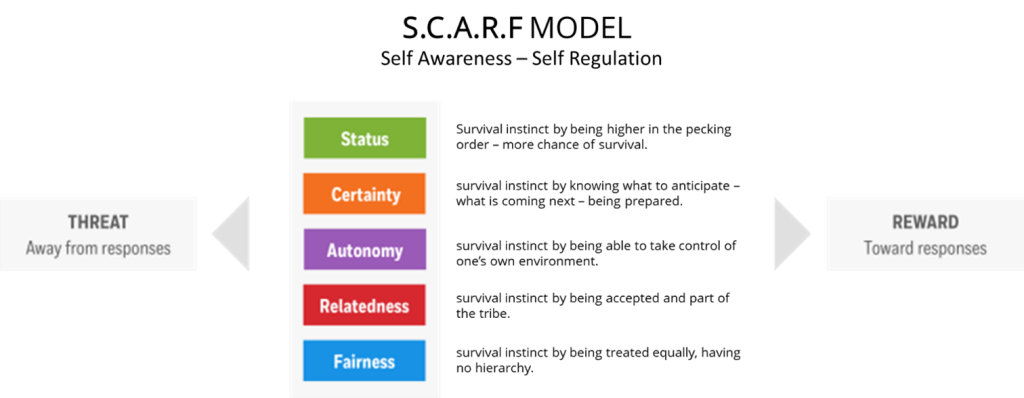Self Regulation

Building your emotional intelligence by improving self regulation (self management)
Improving self regulation using the SCARF Model
The latest research in neuroscience tells us that our neurobiology is what drives our behavior and defines how we, as leaders, make meaning, solve problems, influence and carry out tasks with others. And, core neurobiological human processes play out every day in our actions, thoughts, feelings, and motivations.[1] Understanding our own neurobiology—how we are wired and the deeply social nature of the brain—can help us own the dynamics within us and modernize how we respond to the contemporary complexities of our field.[2].
SCARF Model
To help leaders continue to gain clarity about themselves – David Rock developed SCARF to illuminate two key biological foundations that underpin how humans relate to each other and themselves. In Rock’s own words, these key foundations are as follows:
- Much of our motivation driving social behavior is governed by an overarching organizing principle of minimizing threat and maximizing reward …
- Social needs are treated in the brain in much of the same way as our need for food and water.[3]
So, how does motivation work?
We are intrinsically motivated to move away from perceived threats and toward perceived rewards. This has an impact on your ability to manage self regulation. Any positive emotion or reward generally creates action, whereas a negative emotion or punishment causes a threat stimulus—or activated networks—in our brain, which leads to avoidance.
[4]Neuroscience research findings are helping us see in very tangible ways (for example, by using functional MRIs) that our social needs are on par with our need for food and water. This new science has big implications for the workplace—a highly social situation. In our interactions, our brain is busy classifying everything with a “reward” or “threat” feeling in our body, which then registers in our behavior. Our brains want to know, is something good for us or bad for us?
SCARF Model for Self Regulation
The SCARF model summarizes these two themes within a framework that captures the common factors that can activate a reward or threat response in social situations. The SCARF model involves five domains of human social experience: status, certainty, autonomy, relatedness, and fairness.
- Status is about where you are in relation to others around you.
- Certainty concerns being able to predict the future.
- Autonomy provides a sense of control over events.
- Relatedness is a sense of safety with others, of friend rather than foe.
- Fairness is a perception of impartial and just exchanges between people.

Improving Self-Regulation (Self-Management) Using SCARF
In dealing with managing yourself, here are some recommended steps that have known to be great enablers:
Step 1: Recognise physical symptoms of threat. People react to threats in varied ways. Understanding you own reactions is key.
- Heavier than normal breathing
- Loss of control over articulation.
- Increased blood pressure.
- Increased body temperature.
- Accentuated emotional state.
Step 2: Avoid Reacting in the Moment. Take a break. Reconvene. Ask for time to get back.
Step 3: Assess you trigger (SCARF). Be a scientist not a judge. Get curious about your emotional state.
Step 4: Choose how you wish to respond. Take control of your emotion. See how you can best salvage the situation.

Acknowledgements
[1] Young, I. (2008). Mental models: Aligning design strategy with human behavior. Brooklyn, New York: Rosenfeld Media, LLC.
[2] Pillsbury, J. B. (2013). Results based facilitation: Moving from talk to action. Arlington, VA: Sherbrooke Consulting, Inc.
[3] Rock, D. (2008). SCARF: A brain-based model for collaborating with and influencing others. Neuroleadership Journal, 1, 1–9.
[4] https://childcareta.acf.hhs.gov/systemsbuilding/systems-guides/leadership/leading-ourselves/scarf-model